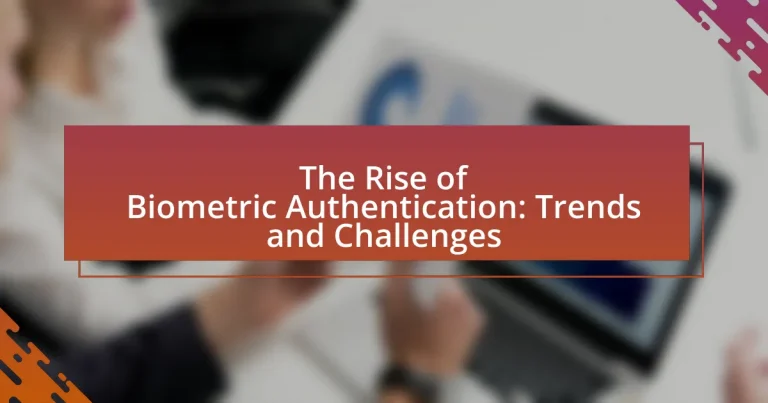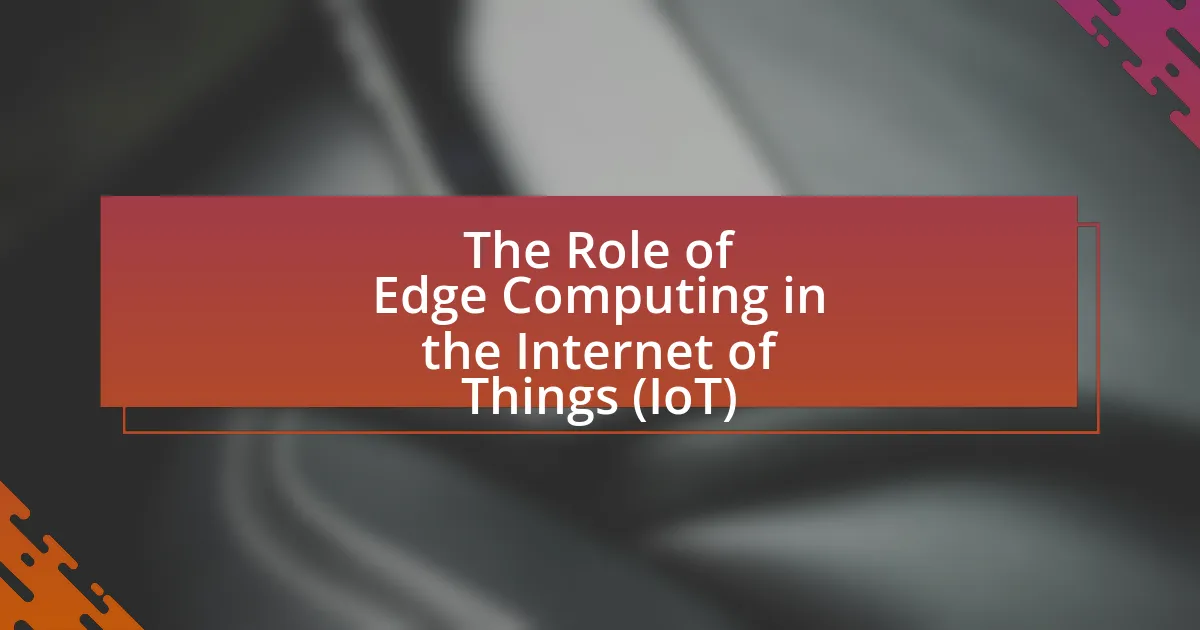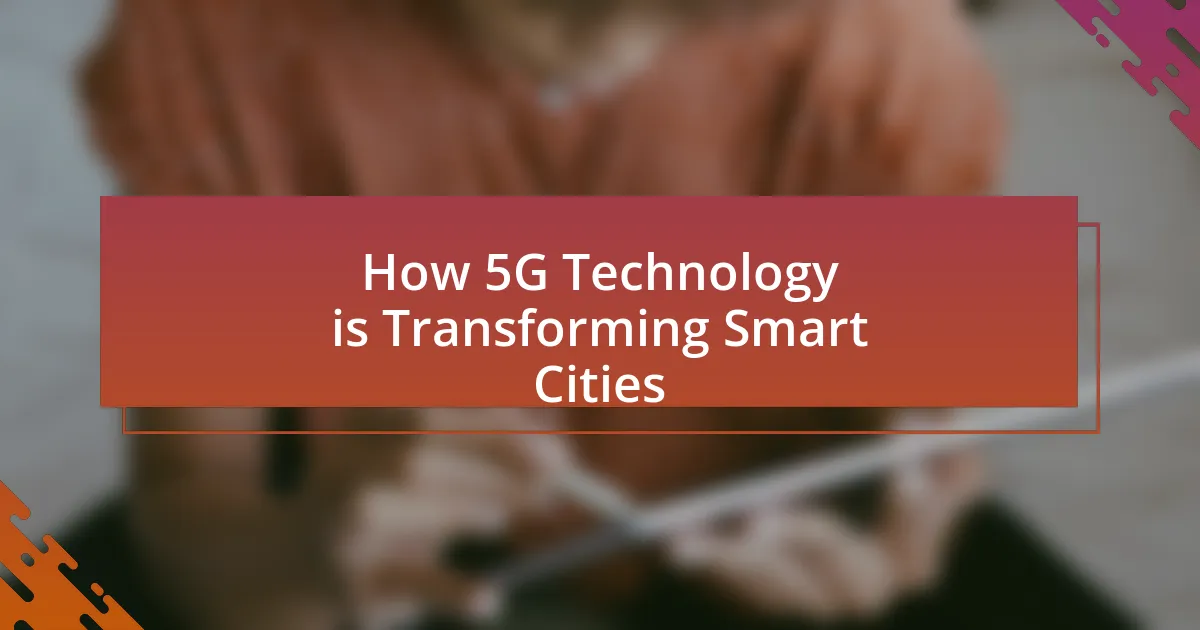Biometric authentication is a security process that verifies individual identities through unique biological characteristics such as fingerprints, facial recognition, and iris patterns. The article explores the mechanisms, technologies, and types of biometric authentication, highlighting its growing adoption across various sectors, including banking and healthcare, driven by advancements in technology and rising security concerns. It also addresses the challenges faced by biometric systems, including privacy issues, data breaches, and technical limitations, while discussing current trends and future prospects in the field. Key best practices for organizations implementing biometric authentication are also outlined to enhance security and user trust.
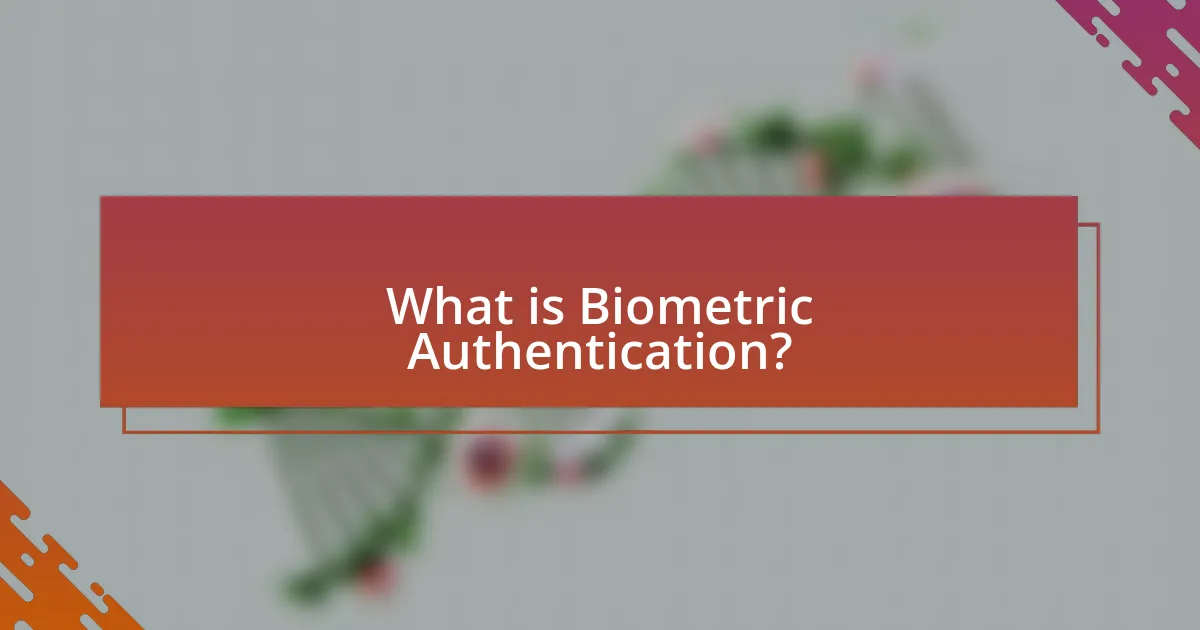
What is Biometric Authentication?
Biometric authentication is a security process that relies on unique biological characteristics of individuals to verify their identity. This method utilizes traits such as fingerprints, facial recognition, iris patterns, and voice recognition, which are difficult to replicate or forge. The effectiveness of biometric authentication is supported by its increasing adoption in various sectors, including banking and mobile devices, where it enhances security and user convenience. According to a report by MarketsandMarkets, the biometric authentication market is projected to grow from $3.8 billion in 2020 to $8.5 billion by 2025, indicating a significant trend towards its implementation in response to rising security concerns.
How does Biometric Authentication work?
Biometric authentication works by using unique biological characteristics of individuals to verify their identity. This process typically involves capturing a biometric sample, such as a fingerprint, facial recognition, or iris scan, and converting it into a digital template. The system then compares the captured template against stored templates in a database to determine a match. For instance, fingerprint scanners analyze the unique patterns of ridges and valleys on a finger, while facial recognition systems utilize algorithms to identify key facial features. The accuracy of biometric authentication is supported by studies indicating that fingerprint recognition can achieve accuracy rates exceeding 99%, making it a reliable method for identity verification.
What are the key technologies used in Biometric Authentication?
Key technologies used in biometric authentication include fingerprint recognition, facial recognition, iris recognition, voice recognition, and palm vein recognition. Fingerprint recognition utilizes unique patterns on an individual’s fingertips, while facial recognition analyzes facial features and their spatial relationships. Iris recognition captures the unique patterns in the colored part of the eye, and voice recognition identifies individuals based on their vocal characteristics. Palm vein recognition scans the unique vein patterns in a person’s palm. These technologies are widely adopted due to their accuracy and security, with fingerprint recognition being one of the most common methods, used in devices like smartphones and security systems.
How do biometric systems capture and process data?
Biometric systems capture and process data by utilizing sensors to collect unique biological traits, such as fingerprints, facial features, or iris patterns. These sensors convert the physical traits into digital signals, which are then processed using algorithms to create a biometric template. This template is stored in a database for future comparison. For example, fingerprint scanners analyze ridge patterns and minutiae points, while facial recognition systems assess key facial landmarks. The accuracy of these systems is supported by studies indicating that biometric authentication can achieve error rates as low as 0.1% in optimal conditions, demonstrating their reliability in secure identification.
What are the different types of Biometric Authentication?
The different types of biometric authentication include fingerprint recognition, facial recognition, iris recognition, voice recognition, and palm print recognition. Fingerprint recognition analyzes the unique patterns of ridges and valleys on an individual’s fingertips, making it one of the most widely used biometric methods. Facial recognition utilizes algorithms to identify and verify individuals based on facial features, while iris recognition scans the unique patterns in the colored part of the eye. Voice recognition analyzes vocal characteristics and patterns for identification, and palm print recognition examines the unique patterns on the palms of hands. Each type leverages distinct biological traits, ensuring a high level of security and accuracy in user identification.
What are the most common biometric modalities?
The most common biometric modalities are fingerprint recognition, facial recognition, iris recognition, voice recognition, and palm print recognition. Fingerprint recognition is widely used due to its uniqueness and ease of capture, with studies indicating that over 70% of biometric systems utilize this modality. Facial recognition technology has gained popularity, especially in security and mobile devices, with a market growth rate projected at 16% annually. Iris recognition offers high accuracy and is used in secure environments, while voice recognition is increasingly integrated into virtual assistants. Palm print recognition is also emerging as a reliable modality, particularly in access control systems.
How do different biometric methods compare in terms of accuracy and security?
Different biometric methods exhibit varying levels of accuracy and security, with fingerprint recognition generally being the most widely used due to its balance of both factors. Fingerprint systems typically achieve accuracy rates above 98%, while facial recognition can vary significantly, with some systems reporting accuracy as low as 80% under poor lighting conditions. Iris recognition is noted for its high accuracy, often exceeding 99%, but it requires more sophisticated hardware, which can impact security if not properly implemented.
In terms of security, fingerprint and iris recognition are considered more secure than facial recognition, which can be susceptible to spoofing through photographs or videos. A study by the National Institute of Standards and Technology (NIST) found that iris recognition systems have a lower false acceptance rate compared to facial recognition systems, reinforcing their security advantage. Overall, while all biometric methods have their strengths and weaknesses, fingerprint and iris recognition are generally regarded as the most accurate and secure options available.
What are the historical trends in Biometric Authentication?
Historical trends in biometric authentication show a significant evolution from simple fingerprint recognition in the late 19th century to advanced multi-modal systems today. Initially, biometric systems focused on fingerprints, with the first recorded use by Alphonse Bertillon in 1893 for criminal identification. The 1960s saw the introduction of automated fingerprint identification systems (AFIS), which enhanced accuracy and speed. In the 1990s, facial recognition technology emerged, followed by iris recognition in the early 2000s, expanding the range of biometric modalities. The rise of mobile devices in the 2010s popularized fingerprint and facial recognition for consumer authentication, leading to widespread adoption in smartphones and security systems. By 2020, biometric authentication had become integral to identity verification across various sectors, including finance, healthcare, and law enforcement, driven by advancements in machine learning and artificial intelligence.
How has the adoption of Biometric Authentication evolved over the years?
The adoption of biometric authentication has significantly increased over the years, transitioning from niche applications to widespread use across various sectors. Initially, biometric systems were primarily utilized in high-security environments, such as government and military applications, due to their complexity and cost. However, advancements in technology, including the miniaturization of sensors and improvements in algorithms, have made biometric authentication more accessible and affordable.
By the early 2000s, fingerprint recognition began to gain traction in consumer devices, notably with the introduction of biometric-enabled smartphones. According to a report by MarketsandMarkets, the global biometric authentication market was valued at approximately $20 billion in 2020 and is projected to reach over $60 billion by 2025, indicating a robust growth trajectory.
The rise of mobile payments and online security concerns has further accelerated the adoption of biometric methods, with facial recognition and iris scanning becoming common features in smartphones and security systems. As of 2023, biometric authentication is now a standard security measure in various applications, including banking, healthcare, and travel, reflecting a significant evolution in its adoption and integration into everyday life.
What technological advancements have influenced the rise of Biometric Authentication?
Technological advancements such as improved sensor technology, machine learning algorithms, and enhanced data encryption have significantly influenced the rise of biometric authentication. Improved sensor technology, including high-resolution cameras and fingerprint scanners, has increased the accuracy and reliability of biometric systems. Machine learning algorithms enable better pattern recognition and adaptability, allowing systems to learn from user behavior and improve over time. Enhanced data encryption ensures that biometric data is securely stored and transmitted, addressing privacy concerns and fostering user trust. These advancements collectively contribute to the widespread adoption and effectiveness of biometric authentication solutions in various sectors.
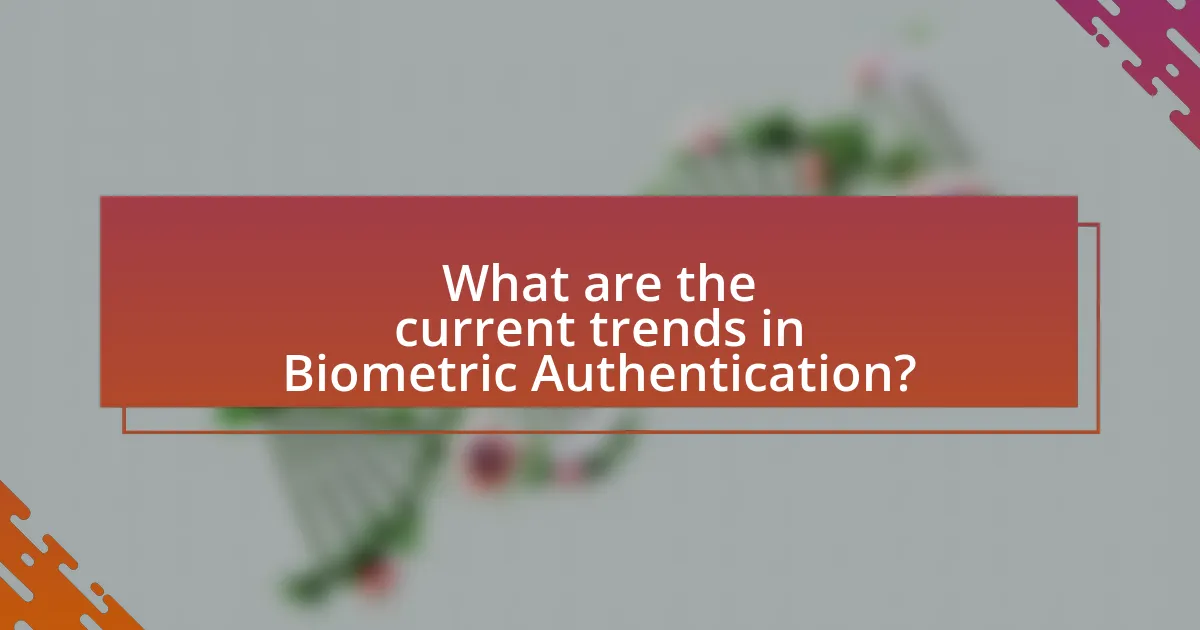
What are the current trends in Biometric Authentication?
Current trends in biometric authentication include the increasing adoption of multi-modal biometric systems, advancements in artificial intelligence for improved accuracy, and a growing emphasis on privacy and data protection. Multi-modal systems combine various biometric traits, such as fingerprints and facial recognition, enhancing security and user convenience. AI technologies are being integrated to analyze biometric data more effectively, reducing false positives and negatives. Additionally, regulatory frameworks are evolving to address privacy concerns, ensuring that biometric data is handled securely and ethically. These trends reflect a shift towards more robust, user-friendly, and privacy-conscious biometric authentication solutions.
How is Biometric Authentication being integrated into modern technology?
Biometric authentication is being integrated into modern technology through the implementation of fingerprint scanners, facial recognition systems, and iris recognition in devices such as smartphones, laptops, and security systems. For instance, Apple introduced Touch ID in 2013, allowing users to unlock devices and make purchases using their fingerprints, while facial recognition technology was further popularized with Face ID in 2017. According to a report by MarketsandMarkets, the biometric authentication market is projected to grow from $24.3 billion in 2020 to $59.3 billion by 2025, indicating a significant trend towards adoption in various sectors, including finance, healthcare, and government. This integration enhances security and user convenience, as biometric traits are unique and difficult to replicate, making them a reliable method for identity verification.
What role do smartphones play in the proliferation of Biometric Authentication?
Smartphones are pivotal in the proliferation of biometric authentication due to their widespread adoption and integration of advanced biometric technologies. The majority of smartphones now come equipped with fingerprint scanners, facial recognition systems, and iris scanners, making biometric authentication accessible to millions of users globally. According to a report by Statista, as of 2021, over 80% of smartphones sold included biometric capabilities, significantly enhancing user convenience and security. This integration not only streamlines the authentication process but also encourages businesses and developers to adopt biometric solutions, further driving the trend in various applications, from mobile banking to secure access control.
How are businesses leveraging Biometric Authentication for security?
Businesses are leveraging biometric authentication for security by implementing technologies such as fingerprint scanning, facial recognition, and iris scanning to enhance access control and identity verification. These methods provide a higher level of security compared to traditional passwords, as they rely on unique biological traits that are difficult to replicate or steal. For instance, a study by the International Data Corporation (IDC) found that organizations using biometric authentication experienced a 50% reduction in security breaches. Additionally, biometric systems streamline user experience by allowing quick and convenient access, which is particularly beneficial in sectors like banking and healthcare where secure and efficient transactions are critical.
What are the emerging applications of Biometric Authentication?
Emerging applications of biometric authentication include mobile device security, financial transactions, healthcare access, and border control. In mobile device security, fingerprint and facial recognition technologies are increasingly used to unlock smartphones and authorize app access, enhancing user convenience and security. In financial transactions, biometric systems facilitate secure payments and identity verification, reducing fraud risks; for instance, banks are adopting voice recognition for customer service interactions. In healthcare, biometric authentication ensures secure access to patient records and medical devices, improving data protection and compliance with regulations like HIPAA. Lastly, border control agencies are implementing biometric systems, such as facial recognition and iris scanning, to streamline immigration processes and enhance national security. These applications reflect a growing trend towards integrating biometric technologies across various sectors to improve security and user experience.
How is Biometric Authentication being used in financial services?
Biometric authentication is being used in financial services to enhance security and streamline customer access to accounts. Financial institutions implement biometric methods such as fingerprint scanning, facial recognition, and voice recognition to verify user identities, reducing the risk of fraud and unauthorized access. For instance, a report by the International Data Corporation (IDC) indicates that 80% of banks are investing in biometric technologies to improve customer authentication processes. This trend reflects a growing reliance on biometrics to meet regulatory compliance and customer demand for secure, convenient banking experiences.
What impact does Biometric Authentication have on healthcare security?
Biometric authentication significantly enhances healthcare security by providing a reliable method for verifying the identity of patients and healthcare professionals. This technology reduces the risk of unauthorized access to sensitive medical records and ensures that only authenticated individuals can access patient data. According to a report by the National Institute of Standards and Technology, biometric systems can achieve accuracy rates exceeding 99%, which is crucial in preventing identity theft and fraud in healthcare settings. Additionally, the integration of biometric authentication can streamline patient check-ins and improve overall operational efficiency, further reinforcing security measures within healthcare facilities.
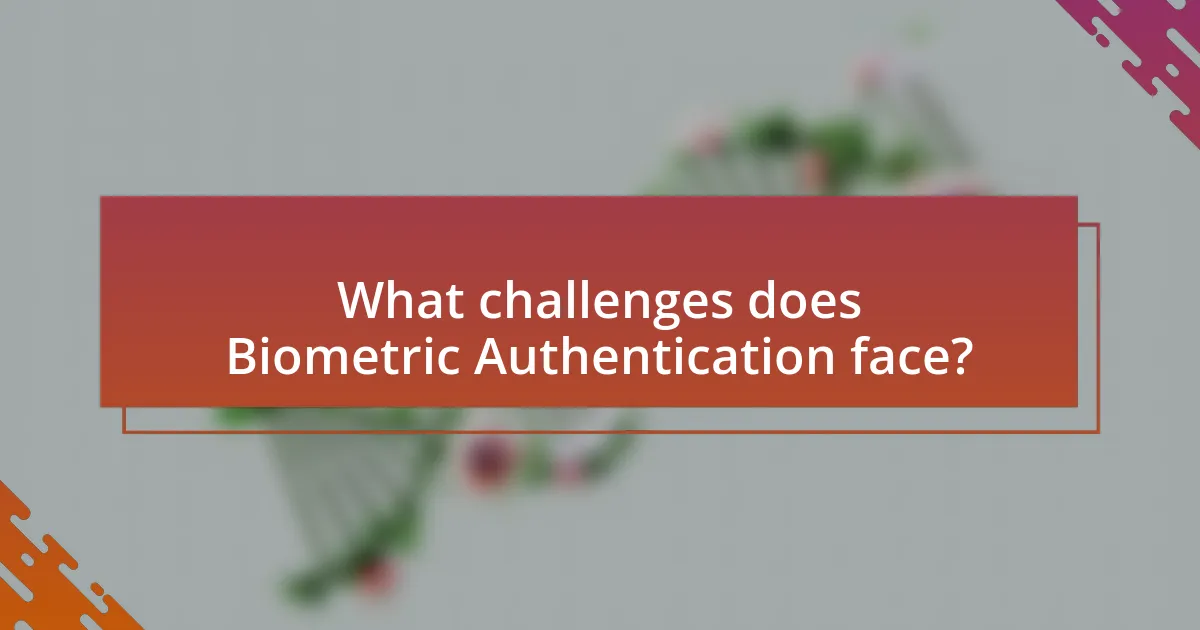
What challenges does Biometric Authentication face?
Biometric authentication faces several significant challenges, including privacy concerns, security vulnerabilities, and the potential for false positives or negatives. Privacy concerns arise because biometric data, such as fingerprints or facial recognition, is sensitive and can be misused if not properly protected. Security vulnerabilities exist as biometric systems can be susceptible to spoofing attacks, where fake biometric traits are used to gain unauthorized access. Additionally, the accuracy of biometric systems can be compromised by environmental factors or changes in an individual’s physical appearance, leading to false positives or negatives that can hinder user experience and trust in the technology.
What are the privacy concerns associated with Biometric Authentication?
Biometric authentication raises significant privacy concerns primarily due to the potential for misuse of personal data. The unique biological traits used in biometric systems, such as fingerprints or facial recognition, cannot be changed if compromised, unlike passwords. This permanence increases the risk of identity theft and unauthorized surveillance. Furthermore, data breaches involving biometric databases can expose sensitive information, leading to unauthorized access to personal accounts and services. Studies indicate that 64% of consumers express concerns about how their biometric data is stored and used, highlighting the need for stringent data protection measures.
How do data breaches affect user trust in Biometric Authentication?
Data breaches significantly undermine user trust in biometric authentication systems. When personal biometric data, such as fingerprints or facial recognition data, is compromised, users become concerned about the security and privacy of their sensitive information. A study by the Ponemon Institute in 2020 found that 60% of consumers would stop using a service if they learned it had experienced a data breach, highlighting the direct correlation between breaches and diminished trust. Furthermore, the irreversible nature of biometric data—unlike passwords, which can be changed—exacerbates user anxiety, leading to a reluctance to adopt biometric solutions. This erosion of trust can hinder the widespread acceptance and implementation of biometric authentication technologies.
What regulations are in place to protect biometric data?
Regulations protecting biometric data include the General Data Protection Regulation (GDPR) in the European Union, which classifies biometric data as sensitive personal data requiring explicit consent for processing. Additionally, the California Consumer Privacy Act (CCPA) mandates businesses to disclose the collection and use of biometric information and allows consumers to opt-out of its sale. The Illinois Biometric Information Privacy Act (BIPA) specifically governs the collection, use, and storage of biometric data, imposing strict requirements on companies to obtain informed consent and implement data protection measures. These regulations collectively aim to safeguard individuals’ privacy and control over their biometric information.
What are the technical challenges of implementing Biometric Authentication?
The technical challenges of implementing biometric authentication include issues related to data security, accuracy, and interoperability. Data security is critical because biometric data, once compromised, cannot be changed like passwords, making it a prime target for cyberattacks. Accuracy challenges arise from false acceptance and rejection rates, which can lead to unauthorized access or denial of legitimate users. Interoperability issues occur when different biometric systems cannot communicate or share data effectively, hindering widespread adoption. According to a study by the National Institute of Standards and Technology (NIST), the performance of biometric systems can vary significantly based on environmental conditions and the quality of the biometric samples collected, further complicating implementation.
How do environmental factors affect the performance of biometric systems?
Environmental factors significantly impact the performance of biometric systems by influencing the accuracy and reliability of biometric data capture. For instance, factors such as lighting conditions, temperature, humidity, and background noise can affect the quality of biometric readings, leading to higher false acceptance or rejection rates. Research indicates that extreme temperatures can cause physiological changes in users, affecting fingerprint or facial recognition accuracy, while poor lighting can hinder the effectiveness of facial recognition systems. Additionally, environmental noise can interfere with voice recognition systems, reducing their performance. These factors collectively demonstrate that the operational environment plays a crucial role in the effectiveness of biometric authentication technologies.
What are the limitations of current biometric technologies?
Current biometric technologies face several limitations, including issues of accuracy, privacy concerns, and susceptibility to spoofing. Accuracy can be compromised by environmental factors, such as lighting for facial recognition or skin conditions for fingerprint scanning, leading to false rejections or acceptances. Privacy concerns arise from the collection and storage of sensitive biometric data, which can be vulnerable to breaches, as evidenced by incidents like the 2015 U.S. Office of Personnel Management hack, where personal data of over 21 million individuals was exposed. Additionally, biometric systems can be tricked by high-quality replicas, such as silicone fingerprints or facial masks, undermining their security effectiveness.
What are the future prospects for Biometric Authentication?
The future prospects for biometric authentication are highly promising, driven by advancements in technology and increasing demand for secure identification methods. The global biometric authentication market is projected to grow significantly, with estimates suggesting a compound annual growth rate (CAGR) of over 20% from 2021 to 2028, reaching a market size of approximately $60 billion by 2028. This growth is fueled by the rising adoption of biometric systems in various sectors, including banking, healthcare, and government, as organizations seek to enhance security and streamline user experiences. Additionally, innovations such as multimodal biometrics, which combine multiple biometric traits for improved accuracy, are expected to further enhance the effectiveness and reliability of biometric authentication systems.
How might advancements in AI influence Biometric Authentication?
Advancements in AI are likely to enhance biometric authentication by improving accuracy, speed, and security. AI algorithms can analyze biometric data, such as fingerprints, facial recognition, and iris scans, with greater precision, reducing false acceptance and rejection rates. For instance, deep learning techniques have been shown to increase the accuracy of facial recognition systems by up to 99.8%, as reported in a study by the National Institute of Standards and Technology (NIST). Furthermore, AI can enable adaptive learning, allowing biometric systems to evolve and improve over time by learning from new data inputs, thus staying ahead of potential spoofing attacks. This integration of AI into biometric authentication systems not only streamlines user experience but also fortifies security measures against increasingly sophisticated threats.
What trends are expected to shape the future of Biometric Authentication?
The future of biometric authentication is expected to be shaped by advancements in artificial intelligence, increased integration of multi-factor authentication, and the growing emphasis on privacy and data protection. Artificial intelligence enhances biometric systems by improving accuracy and reducing false positives through machine learning algorithms. Multi-factor authentication, which combines biometrics with other security measures, is becoming more prevalent as organizations seek to bolster security against sophisticated cyber threats. Additionally, as regulations around data privacy tighten, there will be a stronger focus on ensuring that biometric data is collected, stored, and processed in compliance with legal standards, thereby fostering user trust and acceptance.
What best practices should organizations follow when implementing Biometric Authentication?
Organizations should follow several best practices when implementing biometric authentication to ensure security and user acceptance. First, they must prioritize data protection by encrypting biometric data both in transit and at rest, as this mitigates the risk of data breaches. According to a report by the National Institute of Standards and Technology (NIST), encryption significantly reduces the likelihood of unauthorized access to sensitive information.
Second, organizations should implement multi-factor authentication (MFA) alongside biometric systems. This approach enhances security by requiring additional verification methods, such as passwords or security tokens, which can reduce the risk of spoofing attacks. Research from the Cybersecurity & Infrastructure Security Agency (CISA) indicates that MFA can prevent up to 99.9% of account compromise attacks.
Third, organizations must ensure compliance with relevant regulations, such as the General Data Protection Regulation (GDPR) in Europe, which mandates strict guidelines for the processing of personal data, including biometric information. Compliance not only protects user privacy but also helps organizations avoid legal penalties.
Finally, organizations should conduct regular security audits and user training to identify vulnerabilities and educate users about the importance of biometric security. A study by the Ponemon Institute found that organizations that conduct regular security training experience 50% fewer security incidents.
By following these best practices, organizations can effectively implement biometric authentication while safeguarding user data and enhancing overall security.
